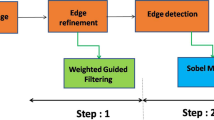Abstract
Moving object segmentation is one of the most challenging issues in computer vision. In this paper, we propose a new algorithm for static camera foreground segmentation. It combines Gaussian mixture model (GMM) and active contours method, and produces much better results than conventional background subtraction methods. It formulates foreground segmentation as an energy minimization problem and minimizes the energy function using curve evolution method. Our algorithm integrates the GMM background model, shadow elimination term and curve evolution edge stopping term into energy function. It achieves more accurate segmentation than existing methods of the same type. Promising results on real images demonstrate the potential of the presented method.
Similar content being viewed by others
References
Stauffer C, Grimson W E L. Learning patterns of activity using real-time tracking. TPAMI, 2000, 22(8): 747–757
Kass M, Witkin A, Terzopoulos D. Snakes: active contour models. Int J Comput Vis, 1988, 1(4): 321–331
Chan T, Vese L. Active contours without edges. IEEE Trans Image Process, 2001, 10(2): 266–277
Howe N R, Deschamps A. Better foreground segmentation through graph cuts. http://www.citebase.org/cgibin/citations?id=oai:arXiv.org:cs/0401017, 2004.
Sun Y D, Li B, Yuan B Z, et al. Better foreground segmentation for static cameras via new energy form and dynamic graph-cut. In: ICPR, 2006
Boykov Y, Jolly M. Interactive graph cuts for optimal boundary and region segmentation of objects in n-d images. In: ICCV, 2001
Mansouri A R. Region tracking via level set PDEs without motion computation. IEEE Trans Patt Anal Mach Intell, 2002, 24(7): 947–961
Suri J S, Liu K, Singh S, et al. Shape recovery algorithms using level sets in 2-D/3-D medical imagery: a state-of-the-art review. IEEE Trans Inf Tech Biomed, 2002, 6(1): 8–28
Sundaramoorthi G, Yezzi A, Meunuccis A, et al. Sobolev active contours. In: VLSM, 2005. 109–120
Rathi Y, Vaswani N, Tannenbaum A, et al. Particle filtering for geometric active contours and application to tracking deforming objects. In: IEEE CVPR, 2005
Sun Y, Yuan B. Hierarchical gmm to handle sharp changes in moving object detection. Electr Lett, 2004, 40(13): 801–802
Osher S, Sethian J A. Fronts propagating with curvaturedependent speed: Algorithms based on Hamilton-Jacobi Formulation. J Comput Phys, 1988, 79: 12–49
Author information
Authors and Affiliations
Corresponding author
Additional information
Supported by National Basic Research Program of China (Grant No. 2006CB303105), the Chinese Ministry of Education Innovation Team Fund Project (Grant No. IRT0707), the National Natural Science Foundation of China (Grant Nos. 60673109 and 60801053), Beijing Excellent Doctoral Thesis Program (Grant No. YB20081000401), Beijing Municipal Natural Science Foundation (Grant No. 4082025), and Doctoral Foundation of China (Grant No. 20070004037)
Rights and permissions
About this article
Cite this article
Wan, C., Yuan, B. & Miao, Z. A moving object segmentation algorithm for static camera via active contours and GMM. Sci. China Ser. F-Inf. Sci. 52, 322–328 (2009). https://doi.org/10.1007/s11432-009-0052-6
Received:
Accepted:
Published:
Issue Date:
DOI: https://doi.org/10.1007/s11432-009-0052-6




